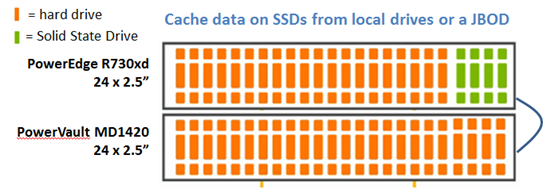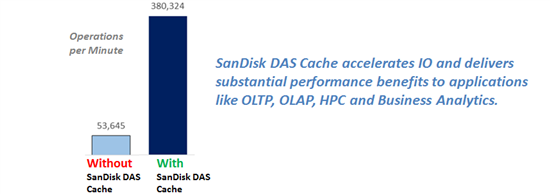The bottom line in most enterprises is productivity, because that is directly translatable to profitability – more productivity means making more money – the bottom line.
In the 13th generation of PowerEdge servers, one way we have helped increase productivity for enterprises is by radically increasing the amount of storage closer to compute – and by introducing many more options for that storage to be (much faster) solid state devices. But did you know that you can actually combine these two storage advantages to greatly accelerate application performance? You can, by using SanDisk DAS Cache software.
Why should I cache data?
The principle behind caching is relatively simple. Typically, only a small amount of all data stored on an enterprise’s drives is actively used on a regular basis. This is sometimes referred to as the “hot” data. So, by assigning a small amount of your storage as the cache – and using faster devices for that storage (solid state drives) – the effective performance of your storage is improved. SanDisk DAS cache can intelligently recognize the active data set and store (cache) it on the faster cache drives. Maintaining hot data in an SSD-based cache delivers much greater performance than using all hard disk drives.
Obviously, faster performance leads to higher levels of productivity in enterprises, including quicker analysis, more transactions in a shorter period of time, more concurrent users, and so on. But in addition, DAS cache provides a way to economize on improved performance. With this technology, you don’t necessarily need to update all your storage to solid state to reap the advantages of solid state performance. Once the active data is in cache – you essentially have the performance of an all solid state environment.
Want even better performance? Use even faster drives for the cache!
With SanDisk DAS Cache you can vary the speed of your operation’s performance by simply changing the level of performance of the drives you are using for the cache. As the chart below shows, there is an order of magnitude leap going from hard drives to SATA SSDs, and if you are willing to make a larger investment in NVMe PCIe drives there is a mindbendingly huge gain in performance. So, if you truly want the fastest cache performance you can get, you can opt for the ultra-low latency, ultra-high performance NVMe drives as your cache. It comes with a premium price, but the productivity payback should make it a consideration in your decision process.
|
Storage device |
IOPs |
Throughput |
| 2.5” 15K hard drive |
264 |
183 MB/s |
| 1.8” SATA SSD |
30,000 |
450 MB/s |
| 2.5” SATA SSD |
30,000 |
450 MB/s |
| 2.5” NVMe PCIe SSD |
700,000+ |
3.0 GB/s |
This table makes it easy to see the performance jump possible from hard drives to SSDs, and the extreme performance advantage of NVMe PCIe devices.
DAS Cache on an FX architecture platform
As the earlier diagram illustrated, SanDisk DAS cache lets you cache data from devices that are direct attached either in the server chassis itself, like an R730xd or an FD332 storage block, or from a PowerVault JBOD.
A great example of DAS cache using the FX architecture is detailed in a whitepaper by Principled Technologies that uses a 4 socket FC830 and 2 FD332 storage blocks to run 18 VMS with OLTP database workloads (enabling 4.5 times as many VMs as a similar previous generation system).
Not only does this configuration enable more VMs than the previous generation – it also allows for 5 times the available storage and achieves 43 times more operations per minute. Even on the same FC830/FD332 configuration – just adding DAS cache gives you 7 times more OPMs:
An eye-opening comparison of caching with SATA SSD and PCIe drives
Another whitepaper by Principled Technologies illustrates the performance advantage available from using PCIe drives as your data cache. They tested two different configurations of an R730xd against a similar competitive system running database workloads – one caching with SATA SSDs and the other caching with PCIe SSDs.
Both configurations outstripped the competitive system by supporting 6 times the number of users. Furthermore, the SATA-configured system reduced response time by 59% while the PCIe-configured system reduced response time by 75%.
So… money…
If you are looking for efficient ways to maximize the performance of your operations, you should seriously consider and evaluate how the DAS cache options available in PowerEdge servers can bring significant performance advantages without disrupting your operations or budget. SanDisk DAS Cache technology will be on display in the Exposition area of the upcoming Dell World (Oct. 20-22 in Austin, Texas) along with all the latest technologies that Dell is bringing to market. Register now, and start planning your agenda. We hope to see you there!




